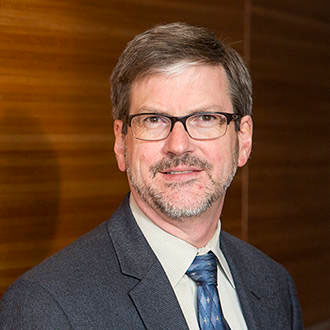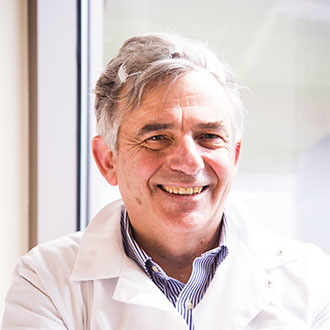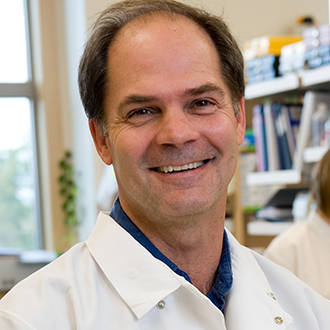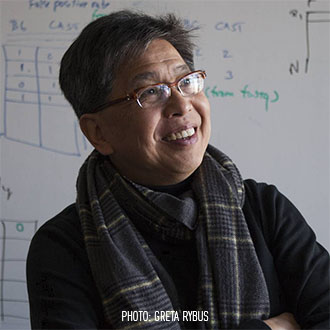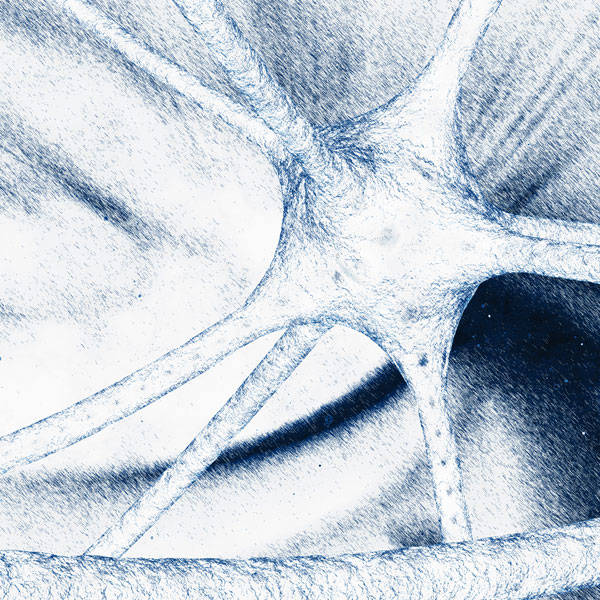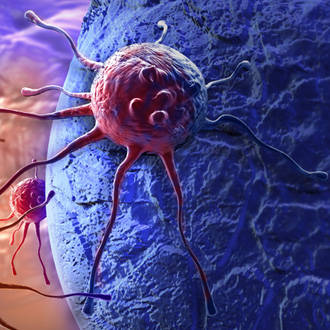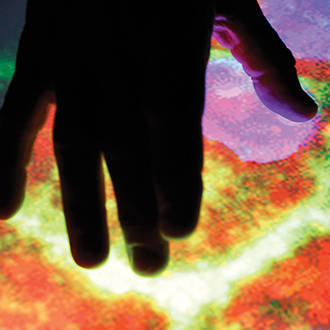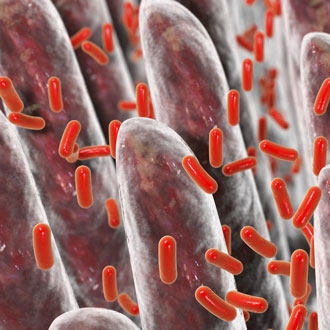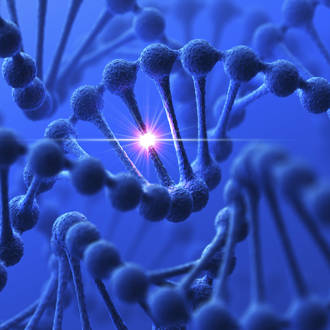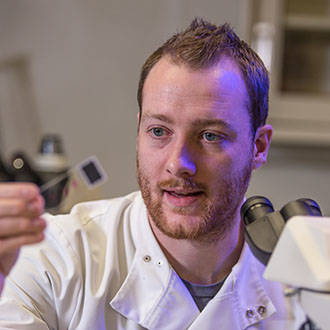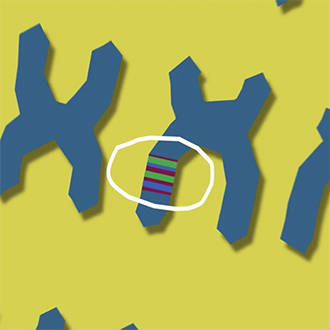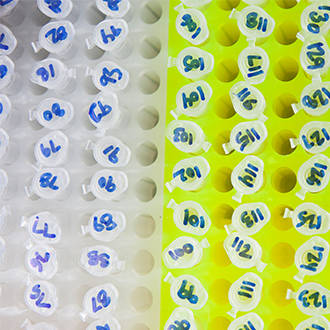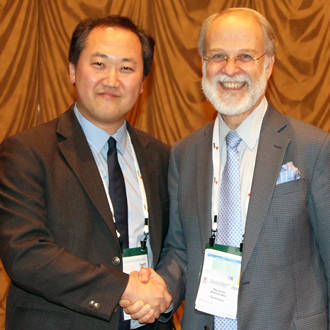Empowering Medicine2016 Annual Report

Dear Friends,
I am pleased to present you with The Jackson Laboratory's annual report for 2016. The year was one of impressive accomplishments and steady growth across all areas, including recruitment of new faculty, construction of enhanced facilities to support our mission, financial performance and increased philanthropy, and significant research contributions in areas ranging from neuroscience and cancer to the microbiome.
All of this growth is focused on a single purpose: the transformation of human health through scientific discovery in complex genetics and functional genomics.
At JAX, we are empowering medicine through our own innovative research, through scientific education programs that reach an ever-expanding audience, and by providing the global research community with the mouse models and services that make discovery possible.
Just as JAX empowers science and medicine around the globe, philanthropic support is a catalyst for our own work, fueling innovation and providing the seed funding that makes it possible for our scientists to explore new ideas, and then leverage them for larger-scale impact.
Our new Alzheimer’s center — one of two major new centers established at JAX in 2016 — exemplifies this process. JAX scientists Gregory Carter, Ph.D., and Gareth Howell, Ph.D., used small grants from our Director’s Innovation Fund, funded in part by gifts to the Laboratory, to launch new collaborative research projects. The promising results they were able to obtain in the early phases of their work together enabled Carter, Howell and their collaborators at Indiana University to secure an impressive five-year, $25 million federal grant to support the new center, which will develop precision models for Alzheimer’s disease research that can be used by researchers worldwide.
Ultimately, success in scientific research is measured not in grant dollars or publications but in the impact on real human lives. Howell, Carter, and their colleagues hope that the development of improved mouse models of Alzheimer’s disease will accelerate the discovery and testing of new therapies to help people facing this disease. And they are not alone. All of us at JAX are equally committed to empowering medicine through our work. With your support, we will continue to lead discovery that will transform human health.
Edison Liu, M.D.
President and CEO
NewFaculty
New Scientists Join Our Quest to Redefine Medicine
We have hired scientific entrepreneurs dealing with the biggest and most challenging medical problems known to man. We approach curing disease as agile and collaborative scientific teams focused on one mission: to discover precise genomic solutions for disease and empower the global biomedical community in our shared quest to improve human health.
JAX hired 14 new faculty members in 2016, including these in the following areas:
Cancer
The distinguished pediatric oncologist and cancer researcher Ching Lau, M.D., Ph.D., was named the first joint appointment of Connecticut Children's Medical Center, The Jackson Laboratory for Genomic Medicine and the UConn School of Medicine. Lau serves as a professor at JAX, where he specializes in pediatric brain and bone tumor research. He is also the medical director of hematology-oncology at Connecticut Children's and Head of the Division of Pediatric hematology-oncology in the Department of Pediatrics at the UConn School of Medicine.
Computational biology
Peter Robinson, M.D., joined the faculty at JAX Genomic Medicine as a professor. Robinson had been professor of medical genomics at the Charité – Universitätsmedizin Berlin's Institute of Medical Genetics and Human Genetics in Germany. He specializes in developing medical ontologies and other bioinformatics resources and algorithms for research and clinical applications.
Roel Verhaak, Ph.D., joined JAX Genomic Medicine as professor and associate director of computational biology. He came to JAX from the University of Texas MD Anderson Cancer Center in Houston and is a recognized leader in big data analysis, with a focus on brain cancer genomics.
Microbiome
Genomics pioneer and bioinformatics expert Mark Adams, Ph.D., joined JAX as director of Microbial Genomic Services. Adams has an extensive background in industry, government, academic and nonprofit settings, where he has focused on applying genomic and bioinformatic approaches to biological research. He comes to JAX from the J. Craig Venter Institute, where he was professor and scientific director, assessing the genomic changes associated with microbial antibiotic resistance. Adams is focused on enhancing JAX's large-scale microbiome initiatives.
Stem cell research
Martin Pera, Ph.D., is a leading stem cell researcher, with associated interests in neuroscience and regenerative medicine. He comes to JAX from The University of Melbourne (Australia), where he is chair of stem cell sciences. He joined the Bar Harbor faculty as professor.
PhilanthropicSupport
Philanthropic Milestones
The Jackson Laboratory raised a record amount of philanthropic support — more than $13.6 million — for its mission in 2016, an 18-percent increase over the previous record, set in 2015. Gifts to JAX in 2016 came from more than 1,460 individual donors, organizations, corporations and private foundations. At the same time, JAX added 380 new donors and saw a 32-percent increase in the average amount of donation received.
2016 Endowed Faculty Chair
Thanks to the generous philanthropic support of Weslie Janeway, a longtime member and current vice chair of the JAX Board of Trustees, a new endowed chair has been established. Janeway’s gift brings the total number of endowed faculty positions at The Jackson Laboratory to six. In addition to providing an important source of funding for research, named, endowed chairs are a vital tool enabling JAX to attract, retain and support outstanding scientists.
JAX President and CEO Edison Liu, M.D., appointed Professor Robert E. Braun, Ph.D., to the Janeway Distinguished Chair. Braun is one of the nation’s leading reproductive biologists, studying germline stem cells and how they develop into eggs and sperm. His lab explores how germline stem cells balance self-renewal with differentiation, and how imbalances between the two can lead to problems ranging from tumor development to sterility.
Bringing precision cancer care to Maine
Addressing cancer treatment in Maine is of the utmost importance. The state has one of the highest incidences of cancer in the country, with about 9,000 new cancer cases each year.
A charitable contribution of $8,410,000 from the Harold Alfond Foundation is supporting JAX’s efforts to enhance cancer diagnostics and treatment in the state through its Maine Cancer Genomics Initiative (MCGI).
JAX’s MCGI is now working with clinicians from every cancer care provider in Maine to enhance oncology providers’ knowledge of cancer genomic technology, and to provide access to advanced genomic tests and educational programs to the Maine oncology community. These tests identify mutations that can be targeted by precision medicine treatments
“We’re dedicated to enhancing cancer care in Maine,” says MCGI Medical Director Jens Rueter, M.D. “We are working to ensure that health-care providers have both the knowledge of and access to the latest diagnostic methods and clinical guidelines so they can select the most promising treatments for each type of tumor, and improve patient outcomes.”
“The Jackson Laboratory is uniquely positioned to apply more than 88 years of expertise in cancer research to the improvement of cancer care in our state,” says Gregory Powell, chairman of the Foundation’s board of trustees. “We are delighted to partner with the Laboratory to improve the health of the people in Maine.”
Most American cancer patients get their care at community hospitals, in rural or suburban settings, and this is especially true in Maine, says Edison Liu, M.D., president and CEO of The Jackson Laboratory and director of The Jackson Laboratory Cancer Center.
“Thanks to the vision of the Harold Alfond Foundation and, working in collaboration with Maine General Medical Center and its Harold Alfond Center for Cancer Care, JAX will work to ensure that all Maine cancer patients and their physicians have access to precision cancer care using the latest advances in genetic technologies, allowing them to determine the best treatment for a particular cancer.”
Established in 1950, the Harold Alfond Foundation furthers the philanthropic legacy of Harold Alfond, the founder of Dexter Shoe Company and a longtime supporter of Maine communities in which he and his family worked and resided. Consistent with Harold Alfond’s own giving pattern and philanthropic principles, the Foundation favors education, health care, youth development and other selected charitable causes.
ResearchMilestones & Highlights
Empowering medicine
JAX research programs are leading efforts to improve human health worldwide, and we have the grants and publications to prove it.
Neurobiology
The National Institute on Drug Abuse made a five-year, $2.4 million grant to Assistant Professor Vivek Kumar, Ph.D., to pinpoint genetic variants that increase susceptibility to addiction. In work published in Nature, Kumar and collaborators also identified two genes that play significant roles in maintaining regular sleep.
The National Institute of Neurological Disorders and Stroke provided funding totaling $1.2 million to JAX Professor Robert Burgess, Ph.D., to develop mouse models for inherited peripheral neuropathies and neurodegenerative diseases including Charcot-Marie-Tooth disease.
The laboratory of Associate Professor Gareth Howell, Ph.D., published research in Nature Scientific Reports on the role of the so-called Western diet on Alzheimer’s disease susceptibility.
Assistant Professor Basile Tarchini, Ph.D., and colleagues published their findings in Development of a mechanism that directs the assembly of the staircase pattern of the hair bundle related to hearing. Tarchini was also awarded a $1.9 million grant from the National Institute on Deafness and Other Communication Disorders.
Associate Research Scientist Lihong Zhao, Ph.D., was the lead author on a paper published in the Proceedings of the National Academy of Sciences, on a new insight into sphingolipid formation and neurodegeneration.
Cancer
President and CEO Edison Liu, M.D.,led research published in the Proceedings of the National Academies of Sciences revealing a genomic configuration that is significantly enriched in triple‑negative breast cancer and other cancers, and that responds to a specific chemotherapy.
In a paper published in Nature Communications, Assistant Professor Jennifer Trowbridge, Ph.D., and JAX colleagues including Assistant Professor Duygu Ucar, Ph.D.,identified the leukemia cell of origin by a new technique: profiling the chromatin in bulk tumor cells.
Immunology
Research published in Cell by Professor Jacques Banchereau, Ph.D., and collaborators at Baylor Institute revealed seven major molecular subgroups of patients with lupus, with implications for better diagnosis and treatment. Banchereau also received a $3.2 million federal research grant to develop adjuvants to improve the efficacy of vaccines in elderly and immunocompromised patients.
The National Institute of Allergy and Infectious Diseases made a five‑year, $3.3 million grant to Professor Derya Unutmaz, Ph.D., to study myalgic encephalomyelitis, the condition more generally known as chronic fatigue syndrome.
Assistant Professor Adam Williams, Ph.D., and colleagues published a paper in Cell providing new insights into how the spleen’s mechanisms for responding to blood-borne antigens could potentially be harnessed to prevent life-threatening immune responses in patients requiring frequent blood transfusions.
Microbiome
The Weinstock laboratory made research agreements with bioMérieux, a multinational diagnostics company, to develop more precise diagnostics for pathogens and their antimicrobial resistances in infectious diseases, and with Connecticut-based Shoreline Biome to develop new diagnostic approaches for disease-causing pathogens, including c. difficile.
Assistant Professor Julia Oh, Ph.D., was the lead author of a paper in mBio demonstrating the use of single-molecule sequencing to better identify and characterize the colonies of microorganisms that live on human skin..
Advanced Genomic Tools
A paper in Cell Research, a Nature journal, by Assistant Professor Albert Cheng, Ph.D., and collaborators announced Casilio, a new system for gene regulation and genomic labeling that marks a major advance over CRISPR-Cas9 alone.
Nature published a paper by Professor Gary Churchill, Ph.D., and Harvard Medical School’s Steve Gygi, Ph.D., explaining their innovative approach to understanding how genetic variants affect protein levels.
A $1.8 million NIH grant to the lab of Associate Professor Gregory Carter, Ph.D., from the National Institute of General Medical Sciences, will fund the development of new computational tools to analyze genomic data to understand how multiple genes interact in complex diseases.
A research team led by Assistant Professor Michael Stitzel, Ph.D., isolated single cells from the pancreatic islets of both non‑diabetic and type 2 diabetic subjects to obtain transcriptomes for each cell, shown in work published in Genome Research.
Data resources
A four-year, $3.4 million NIH grant to Senior Research Scientist Laura Reinholdt, Ph.D., in Genetic Resource Science will help her team develop new data resources and mouse models to better understand Mendelian genetic disorders.
Funding for an important JAX data resource was renewed by the NIH. Associate Professor Martin Ringwald, Ph.D., received$10.5 million to continue the maintenance and development of the Gene Expression Database.
New Center Grants
Empowering medicine: New center grants
Three multi-year grants totaling $55 million, awarded in 2016 to The Jackson Laboratory from the National Institutes of Health, launched new centers for the study of Alzheimer’s disease and addiction, and for the next phase of the Knockout Mouse Project to understand gene function.
JAX President and CEO Edison Liu, M.D., says the awards reflect the “singular, central role of JAX” in the nation’s biomedical research community.
“As the world’s headquarters for mammalian genetics,” Liu says, “JAX is the engine of a new research paradigm: Discoveries at the bench become treatments at the bedside, with patient data informing the next round of bench research.”
The driving force
With the new multimillion dollar awards, JAX now has 56 current grants associated with interdisciplinary Center programs, including the National Cancer Institute-designated Cancer Center, the National Institute on Aging’s Nathan Shock Center of Excellence in the Basic Biology of Aging, the Mouse Genome Database, the Center for Genome Dynamics and the Center for Precision Genetics.
In the United States, funding from the NIH is the lifeblood of basic biomedical research. It is the largest public funder of biomedical research in the world, investing more than $32 billion a year and resulting in medical breakthroughs, enabling people to live longer, healthier lives.
The best-known NIH funding mechanism for research at JAX and other U.S. research institutions is the R01 grant, which provides three to five years of funding to an individual scientist, also known as a principal investigator or PI, enabling him or her to hire staff and pay for the services and materials needed for the lab’s research projects.
Center grants, on the other hand, are typically large-scale projects that may involve several PIs and even multiple institutions. The NIH describes these grants as providing a “multidisciplinary attack on a specific disease entity or biomedical problem area,” noting that Centers “may serve as regional or national resources for special research purposes.”
Over the last decade, budget cuts and sequestrations have resulted in fewer R01 and other grants from the NIH, and thus tighter competition for them. Nevertheless, JAX has a 37-percent success rate in securing federal research grants — nearly twice the national average for research institutions overall.
Masters of complexity
A number of factors makes JAX the ideal recipient of Center awards, say the two principal investigators of the Alzheimer's Disease Precision Models Center, Gregory Carter, Ph.D., and Gareth Howell, Ph.D.
Howell cites the institution’s emphasis on addressing genetic complexity, a growing research faculty with strengths in a variety of different biological areas, and an experimental approach that is “carefully controlled, including consistent genetic backgrounds and minimizing environmental variation.”
Carter notes, “JAX is recognized worldwide for unique genetic resources and expertise in genetic methods to study understand disease, as well as computational strengths and an established history of collaborative research between computational scientists and wet-bench researchers.”
“Most of all,” he adds, “our standing in the research community allows us to assemble multi-institutional teams that combine our strengths with complementary expertise from top researchers in Alzheimer’s disease, addiction, cancer and many other areas.”
The Alzheimer’s center, in fact, is based at both JAX and Indiana University (IU), with co-PIs Bruce Lamb, Ph.D., executive director of the Stark Neurosciences Research Institute at the IU School of Medicine and Paul R. Territo, Ph.D., an expert in biomedical imaging.
The goal of the center is to break the bottleneck in the development of Alzheimer’s disease drugs. More than 5 million Americans are living with Alzheimer’s, a number that is projected to more than double in the coming decades due to the aging U.S. population. While several drugs on the market temporarily abate some symptoms of Alzheimer’s, not one drug can prevent or treat the disease itself. By developing, testing and sharing new mouse models that accurately replicate late-onset Alzheimer’s disease, the research team hopes to fast-track new drugs and better diagnostics.
Precision mouse models, based on patient genetic profiles, are also at the heart of the new Center for Systems Neurogenetics of Addiction. This center will combine the expertise and effort of behavioral neuroscientists from several major universities, computational biologists and geneticists, and take advantage of recent advances in precise genetic, genomic and behavioral analysis in the laboratory mouse.
Elissa Chesler, Ph.D., the PI of the addiction center, says that understanding the genetic factors involved in individuals’ vulnerability to addiction is fundamental to developing therapeutic targets to treat or even prevent addiction.
“Despite extensive evidence that addiction is a disease with variable individual risk,” Chesler says, “there is still a widespread misconception that addiction is a moral failing that is completely under the control of the individual. We want to identify the ways in which some individuals are more likely than others to start using drugs or become addicted to drugs, and to better understand how the brain responds to drugs to explain and treat compulsive drug-seeking.”
Chesler comments that an important factor in securing the JAX addiction center grant was the institution’s significant investments in research infrastructure as well as recruiting faculty experts in complex disease, investments made possible by philanthropic gifts and support from the state of Maine. “For example,” she says, “our Center for Biometric Analysis, now under construction, will greatly expand our ability to collect data on the physiology and behavior of mouse models to understand gene function. That’s vital to all three of the new Center grants.”
Mouse trailblazers
Unlike the Alzheimer’s disease and addiction centers, The Jackson Laboratory Knockout Mouse Production and Phenotyping Project is not focused on a specific disease area. Instead, JAX and two other NIH-funded centers are part of a worldwide effort, the International Mouse Phenotyping Consortium, to genetically and systematically determine the function of every mammalian gene, one gene at a time. The consortium is engaged in the immense task of producing and phenotyping (collecting physiological data from) these mice. Mouse models of gene mutations with common functionality between mice and humans can lead to new models of human disease, which are useful for drug screening, preclinical studies and deeper understanding of biological and disease mechanisms.
“Mice and humans share approximately 20,000 genes,” says JAX Professor and Janeway Distinguished Chair Robert Braun, Ph.D., one of three JAX PIs of the center grant. “But scientists have little or no data forthe function of more than half of these genes.” He says that scientists around the world have been working together since 2006 to generate a targeted knockout mutation for every gene in the mouse genome.
“Deleting individual genes in this way provides valuable clues to the genes’ function,” he said.
Liu says the award of three NIH-funded Center grants in one year validates the JAX approach of collaborative research and sharing data and research resources with the worldwide scientific community.
“These centers represent how basic research is empowering medicine by precisely identifying the complex genetic interactions involved in disease.”
Recognitionfor Excellence
The Laboratory and its people earned recognition for research and innovation in 2016.
JAX President and CEO Edison T. Liu, M.D., was named a Fellow of the American Association for the Advancement of Science. Elected by his peers, Liu was recognized for his distinguished contributions to cancer biology, particularly the molecular analysis of breast cancer, and to the global advancement of human genomics.
The Human Genome Organisation named as its new president Charles Lee, Ph.D., FACMG, professor and scientific director of The Jackson Laboratory for Genomic Medicine and distinguished professor of Ewha Womans University. Lee is a prominent biomedical scientist who first discovered widespread structural variation in the human genome in 2004, in the form of copy number variation.
The Jackson Laboratory partnered with the American Medical Association and Scripps Translational Science Institute to develop a new online program aimed at educating physicians and other health care professionals on the benefits and limitations of genetic testing and when it is appropriate to incorporate it into their practices. The 12-module “Precision Medicine for Your Practice” series focuses on the application of genetic testing, including targeted therapy in oncology, genomic sequencing, cardiogenomics, neurogenomics, pharmacogenomics and ethics in precision medicine.
ContinuedGrowthin 2017
Framing the future of research
The Jackson Laboratory is growing in economic value, with an estimated nationwide total economic impact of nearly $1 billion — a 23 percent increase in just one year — as well as 2,114 direct jobs and 3,185 indirect jobs in California, Connecticut and Maine. But along with its economic impact, the nonprofit Laboratory is also expanding its geographic footprint. Infrastructure that will power research at JAX and around the world is under way in Maine:
In June JAX broke ground for the Center for Biometric Analysis, which will equip scientists with essential, cutting-edge tools for detecting and measuring extremely subtle signs of disease at the cellular level in specialized mice, using high-powered imaging and analytical devices. These analyses, coupled with genomic sequencing and computational biology techniques, are crucial steps to help pinpoint the genetic basis of disease and aid in diagnosis, prevention and treatment.
Two months later, JAX celebrated the groundbreaking for its state-of-the-art vivarium, a 134,900-square-foot facility to maintain research mouse models, at the institution’s new Ellsworth, Maine, location. U.S. Senators Susan Collins and Angus King and Congressman Bruce Poliquin were among the elected officials on hand to launch the new facility. JAX Mice are an international resource, distributed to more than 23,000 research labs in 52 countries, and have enabled breakthroughs in cancer, Alzheimer’s disease, Parkinson’s, cardiology, diabetes, glaucoma and many more diseases and conditions.
Jobs by State
Total 2016 Economic Impact
JAX operations in 2016 drove total estimated economic activity of $968 million in Maine, Connecticut and California.
$968,000,000
* “JAX jobs” are the people employed by JAX itself.
** “Indirect jobs” is an estimate of the number of jobs created by other firms based on JAX expenditures, eg: construction, vendors and suppliers, hospitality and employee spending.
Financials
Operating Revenue FY2016
Operating Expenses FY2016
Operating Revenue & Expenses by Year
Endowment Value by Year
| STATEMENT OF FINANCIAL POSITION (IN MILLIONS) | 2016 | 2015 |
| ASSETS | ||
| Cash and Equivalents | 200.7 | 176.2 |
| Land, Buildings and Equipment | 391.5 | 391.1 |
| Other Assets | 22.1 | 15.3 |
| Endowment Investments | 142.8 | 132.7 |
| Net Receivables | 38.6 | 39.0 |
| Total Assets | 795.7 | 754.3 |
| LIABILITIES AND FUND BALANCES | ||
| Current Liabilities | 60.7 | 60.2 |
| Bonds Payable, Net | 96.2 | 100.2 |
| Connecticut Forgivable Loans at Fair Value | 5.8 | 7.3 |
| Net Assets | 633.0 | 586.6 |
| Total Liabilities and Net Assets | 795.7 | 754.3 |
| STATEMENT OF ACTIVITY (IN MILLIONS) | ||
| OPERATING REVENUE | ||
| Government Support | 74.3 | 75.5 |
| Foundation Grants | 7.5 | 6.5 |
| Philanthropic Gifts | 2.2 | 4.5 |
| Program Revenues | 230.8 | 209.8 |
| Investment Return | 8.9 | 1.3 |
| Other Revenue | 3.3 | 2.7 |
| Operating Revenue | 327.0 | 300.3 |
| OPERATING EXPENSES | ||
| Research | 108.0 | 102.4 |
| Program Expenses | 137.2 | 127.2 |
| Institutional Support | 55.1 | 51.9 |
| Operating Expenses | 300.3 | 281.5 |
| Increase in Net Assets From Operating Activities | 26.7 | 18.8 |
| NON‐OPERATION FINANCIAL SUPPORT | ||
| Construction Grants | 0.0 | 0.1 |
| Contributions for Plant and Endowment | 4.1 | 3.2 |
| Long-Term Investment Return, Net of Amount Used | 7.0 | (1.3) |
| Unrealized Gain (Loss) on Interest Rate Swaps | 1.0 | 0.4 |
| Changes in Actuarial Assumptions Related to Retirement Benefit Plans | 0.0 | 0.5 |
| Adjustment to Fair Value for Connecticut Forgivable Loans | 7.7 | 75.9 |
| Adjustment to Fair Value on Loan Receivable | – | – |
| Other | (0.1) | (4.0) |
| Increase (Decrease) in Net Assets From Non-Operating Activities | 19.7 | 74.9 |
| Increase (Decrease) in Net Assets | 46.4 | 93.6 |








